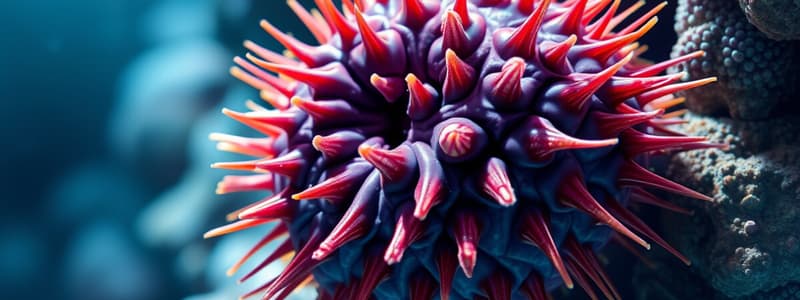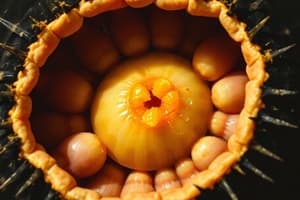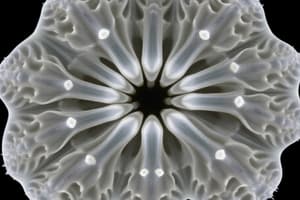Podcast
Questions and Answers
What are spines in sea urchins primarily used for?
What are spines in sea urchins primarily used for?
- Defense
- Respiration
- Eating
- Locomotion (correct)
What material are the teeth of sea urchins made of?
What material are the teeth of sea urchins made of?
Calcium carbonate
What is the function of Aristotle's lantern in sea urchins?
What is the function of Aristotle's lantern in sea urchins?
Chewing mechanism
The _______ is located at the center of the aboral body surface and is used for excretion.
The _______ is located at the center of the aboral body surface and is used for excretion.
What role does the madreporite play in the anatomy of sea urchins?
What role does the madreporite play in the anatomy of sea urchins?
How many pairs of gills are located at the outer edge of the peristome in sea urchins?
How many pairs of gills are located at the outer edge of the peristome in sea urchins?
What type of feeders are sea urchins compared to sea stars?
What type of feeders are sea urchins compared to sea stars?
What do sea urchins primarily feed on?
What do sea urchins primarily feed on?
The _______ are located around the periproct and surround the anus.
The _______ are located around the periproct and surround the anus.
What surrounds the mouth of a sea urchin?
What surrounds the mouth of a sea urchin?
What is the function of buccal podia?
What is the function of buccal podia?
Flashcards are hidden until you start studying
Study Notes
Sea Urchins Overview
- Belong to Phylum Echinodermata and Class Echinoidea.
- Primary consumers (herbivores) primarily feeding on algae and organic matter.
- Important grazers in marine ecosystems such as turtle-grass beds and coral reefs.
Spines
- Spines project from the body surface, aiding in locomotion.
- Typically longer in most sea urchins, formed from calcite crystals.
- Can vary in attributes: solid or hollow, long or short, thick or thin, sharp or blunt.
Teeth
- Characterized by five teeth oriented towards the center.
- Composed of calcium carbonate, each tooth held by a separate jaw.
- Arrangement forms part of a complex structure known as Aristotle's lantern.
Mouth
- Oral opening features five converging teeth and a collar-like lip.
- Utilizes a complex chewing mechanism called Aristotle's lantern for food processing.
- Surrounded by buccal podia, which are five pairs of large oral tube feet assisting in capturing food.
Lip
- Surrounds the sea urchin’s mouth.
- Contains circular or “purse string” muscles assisting in mouth operation.
Anal Plate
- Positioned on top of the sea urchin, between the anus and genital plates.
Madreporite
- A sievelike structure serving as the water intake for the water-vascular system.
- Calcareous, light-colored opening used for filtering water and acting as a pressure regulator.
- It is the largest of the genital plates.
Gills
- Located at the outer edge of the peristome.
- Comprised of five pairs, facilitating gas exchange for respiration.
Buccal Podia
- Five pairs of large oral tube feet that aid in food capture.
Anus
- Muscular opening centrally located on the aboral surface for waste excretion.
Genital Plates
- Larger plates surrounding the periproct, situated at the ends of inter-ambulacral rows.
- Five genital plates each contain a genital pore to allow water ingress into the vascular system.
Aristotle's Lantern
- Internal complex chewing mechanism operated by various muscle sets.
- Comprises a complete system of muscle-operated calcareous plates and jaws for effective food processing.
Trophic Comparison: Sea Urchins vs. Sea Stars
- Sea urchins are herbivores, while sea stars are carnivores (secondary consumers).
- Sea stars consume a diverse diet including mollusks, crustaceans, and small fish.
- Sea urchins primarily graze on algae, organic material, and may also consume matter from sandy bottoms.
Studying That Suits You
Use AI to generate personalized quizzes and flashcards to suit your learning preferences.




